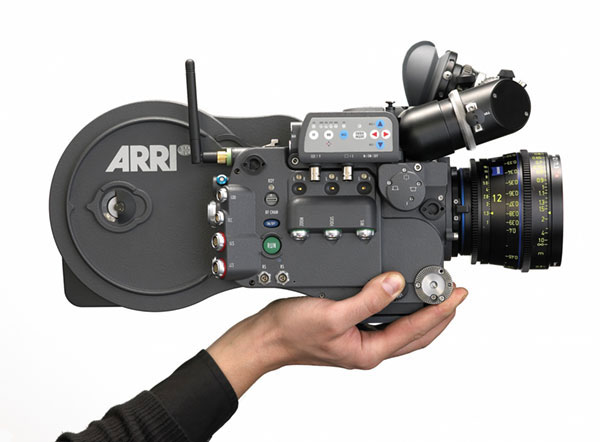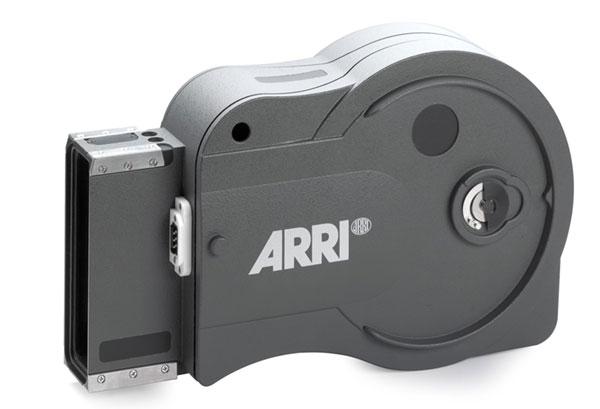Got a chance to play with the Arriflex
416 this past week at NAB and talk with Klemens Kehrer,
the 416's design engineer and Marc Shipman-Mueller, its product
manager. Here's what I found out.
ARRI began work on the camera in late
2004 because of the resurgence in Super 16. The indicators were;
increased sales of the SR3 Advanced cameras, increased footage
sales of Kodak Vision2 16mm film stock, the scarcity of camera
rental stock as the cameras were continuously rented out, the
introduction of the new Cooke and Canon lenses, the refinement
of the DI process allowing Super 16 capture and 35mm release,
and the leap forward in film scanning brought about by the introduction
of the Spirit telecine and the ARRISCAN.
ARRI started with a series of focus groups,
asking cinematographers what they didn't like about the SR3 and
other Super 16 cameras and what they would like to see in a new
camera. Three issues became apparent.
The first issue was with the viewfinder.
The SR3 viewfinder interfered with some wide diameter lenses,
including the new Master Prime lenses, and equally important,
cinematographers wanted a viewfinder that was brighter and easier
to use for critical focus. ARRI addressed the issue by taking
the mechanical design of the Arriflex 235 viewfinder and creating
a new optical design from scratch. The new viewfinder has completely
new glass and gives a brighter, higher resolution and higher
contrast image, and frees up the front of the camera to accept
all the new lenses available. The camera also comes standard
with RGB ARRIGLOW to make framing in difficult light situations
easier. Trying the camera at the ARRI booth, I found the viewfinder
very crisp with a 9.5 Ultra 16 prime mounted.
The second issue was camera noise. The
SR3 Advanced had a noise specification of between 20 dbA and
22 dbA. The 416 has a noise specification of below 20 dbA.
This was accomplished by using rubber insulators to hold the
camera body's inner skeleton and by having the internal skeleton
of the magazine also held by rubber insulators. The magazine
is also not driven anymore by a gear from the camera, but by
its own silent motor. Running the camera containing a 400 foot
load running at 24 fps, I had to press my ear against the side
of the camera to tell if it was running, and even then I could
barely discern a whispered purr. The camera is amazingly quiet.
The third issue was camera ergonomics.
Cinematographers wanted a camera that was lighter weight, easier
to hand hold, and would fit on their shoulder much better than
the SR design. ARRI realized that the electronics had to be
moved from the base of the camera, as in the SR's, so they relocated
them to the right side of the body. The display was kept on
the left side of the body but with the electronics change, the
camera was now too wide. The throat of the old SR magazine design
did not allow for narrowing, so ARRI designed a new magazine
from scratch.

With the new design, when the film travels
through the magazine throat, it is now traveling in a straight
up and down line, instead of at a diagonal line as with the SR.
To accomplish this ARRI had to reversed the feed and take-up
sides of the magazine. Feed is now on the left side and take-up
is on the right. As mentioned earlier, each magazine contains
its own silent motor so there is no gear connection between the
magazine and camera body. The front edges of the magazine throat
have been reinforced so that the magazine can be "slapped"
into the camera without fear of damage.
The magazine loads differently than the
SR but after a brief instructional demonstration, I was able
to load one almost as quickly as I can load my SR. While I was
at the ARRI booth Jon Fauer was also there going over the camera
with Marc and Klemens so I hope to see an Arriflex 416 Book in
the near future.
As far as weight, the stock 416 is 25%
lighter than the stock SR3. The 416 Plus is 28% lighter than
the SR3 and the UMC-3.
While discussing the magazine design
with Klemens, I discovered the following. The entire 416 is
CNC machined from solid blocks of aircraft grade aluminum, there
are no castings used in the camera or magazine. The movement
from the SR3, the SR3 fiber screens and SR3 timecode system are
the only parts from the old camera to carry over to the 416.
The camera runs crystal sync from 1 - 75 fps with speed ramping
throughout the range.

The new Lithium Ion 24 volt battery is
three times more powerful than the SR3 battery and can run five
400 foot magazines and power the camera in standby mode for two
hours on one charge. The battery can also communicate with the
camera which measures power draw and displays how many magazines
can be run with the remaining power in the battery.
The viewfinder and video tap are totally
separate systems, so you can shoot on a tripod with the viewfinder
and the video tap running, then for a Steadicam shot, just take
the camera off the tripod, pop off the viewfinder, put on the
little cover, and attach the camera to a Steadicam. The video
tap, (or IVS in ARRI-speak) is an improved version of the one
used on the 235 which uses electronic sharpening (increase in
contrast) to give a sharper, clearer picture.
There are no plans to make an 800 foot
magazine or a High Speed version of the camera and the SR3 Advanced
High Speed will still be sold.
The stock 416 is without the electronics
for the lens motors and wireless remote control modem. The 416
Plus includes these electronics.
Right now, the goal is to sell the stock
416 for the same price as the stock SR3, and the 416 Plus for
somewhat less than the SR3 plus UMC-3.
Having played with the camera for about
thirty minutes I can say that it is noticeably lighter than the
SR, fits your shoulder quite nicely, has a great viewfinder,
is practically noiseless, and loads as simply as my old SR.
The camera should be available by the
end of the year.
For more information about the camera,
go to:
http://www.arri.com/entry/416.htm
Tim
Carroll splits his time between
directing, cinematography and motion picture camera repair. He
also runs the Arri16S.com web
site.